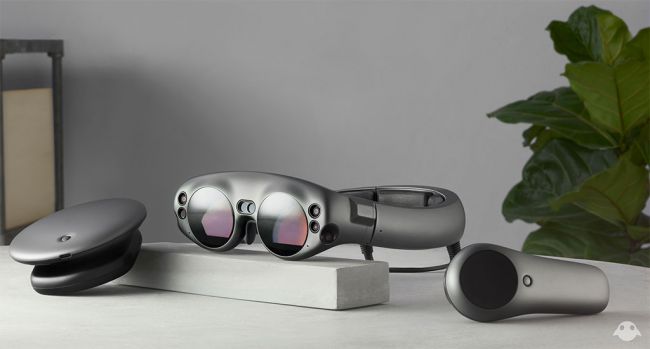So this is what six years of development and $1.9 billion in funding looks like—large goggles built to deliver mixed reality experiences. Magic Leap formally announced the headset today, calling it “Magic Leap One, Creator Edition,” which will ship in 2018 if everything goes to plan.
“We’re adding another dimension to computing. Where digital respects the physical. And they work together to make life better. Magic Leak One is built for creators who want to change how we experience the world,” the company explains on one of its graphics.
Magic Leap is not providing granular details about its AR goggles just yet, though we do know it consists of a bunch of sensors in the front. The headset connects to a circular Lightpack, which Magic Leap tells Rolling Stone is a “powerful pocket-sized computer” with a battery. How powerful?
“Think about something close to like a Mac Book Pro or an Alienware PC. It’s got a powerful CPU and GPU. It’s got a drive, Wi-Fi, all kinds of electronics, so it’s like a computer folded up onto itself,” company founder Rony Abovitz explains.

Abovitz says there’s another powerful “real-time” computer inside the googles “that’s sensing the world and does computer vision processing.” It also has machine learning capabilities.
In total, the system consists of four built-in microphones and six external cameras. The comparisons to Microsoft’s HoloLens are inevitable—the Magic Leap One even has built-in speakers, just like HoloLens.
Everything is built on the idea of creating a digital lightfield.
“Our lightfield photonics generate digital light at different depths and blend seamlessly with natural light to produce lifelike digital objects that coexist in the real world. This advanced technology allows our brain to naturally process digital objects the same way we do real-world objects, making it comfortable to use for long periods of time,” Magic Leap says.
The hype is high, with Magic Leap pointing to a whole bunch of potential users, everything from playing games to interacting with multiple floating displays. How it all pans out remains to be seen, perhaps relatively soon—Magic Leap will make its SDK and support materials available to developers in early 2018.
